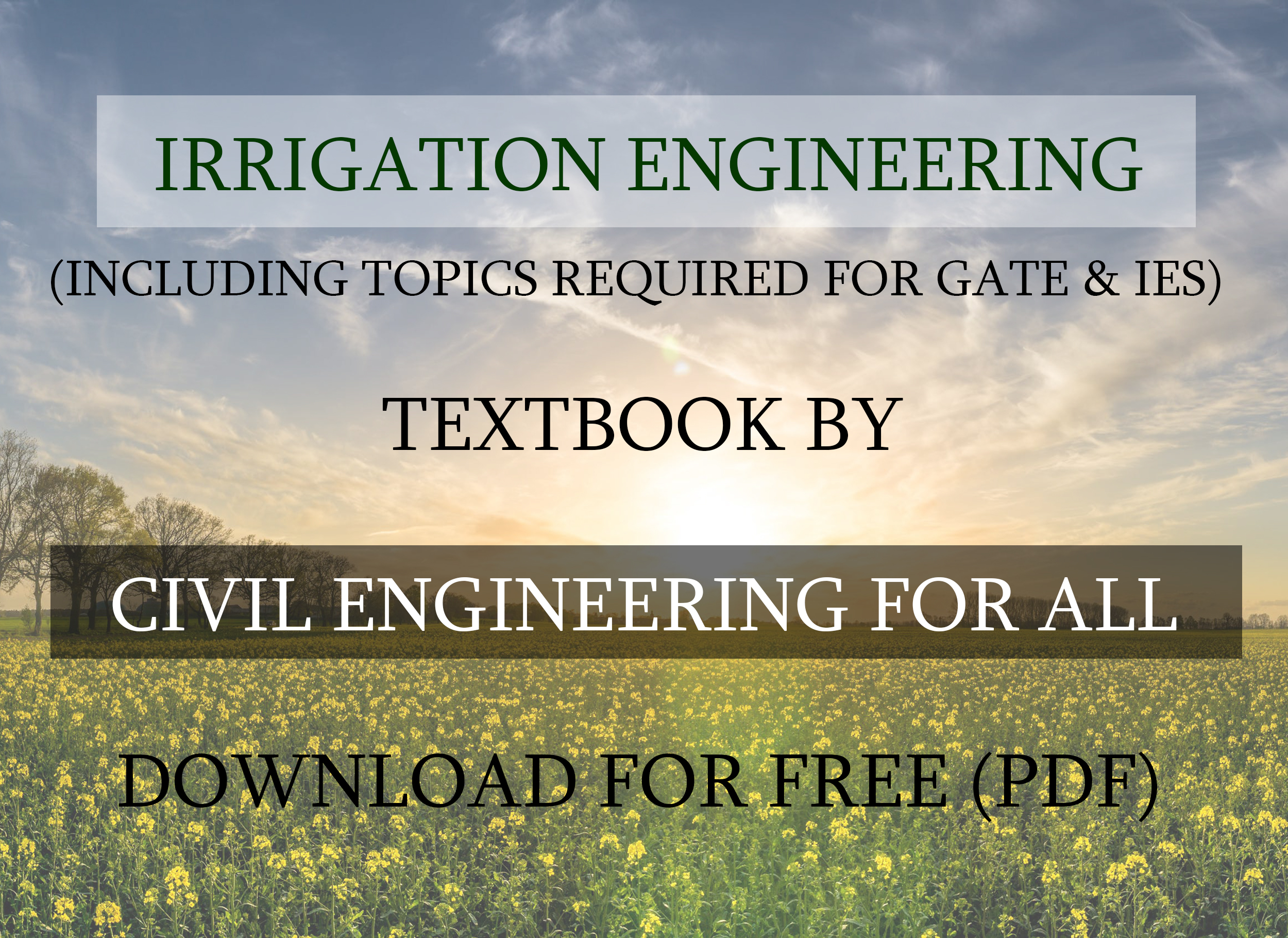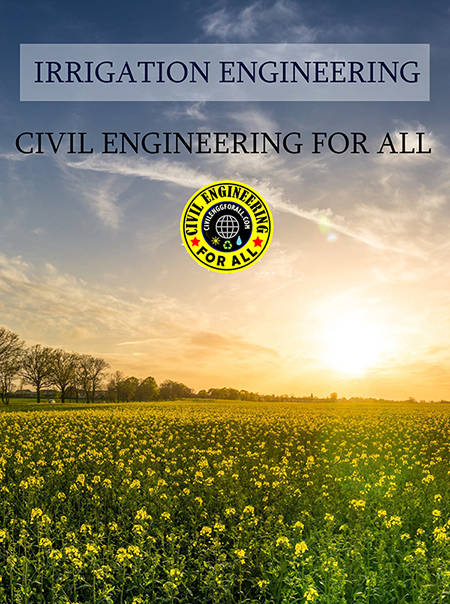

Table of Contents
TOPICS COVERED
| Importance of Irrigation Engineering |
| Estimation of Irrigation Demand |
| Irrigation Schemes and Methods |
| Modern Canal Operation Techniques |
| Design of On-demand Irrigation Systems |
| Mapping Water Networks |
| Drainage Pipes and Accessories |
| Drainage and Disposal Systems |
| Surface and Subsurface Drainage |
| Installation and Maintenance of Drainage Materials |
| Evaluation of Irrigation Project |

BENEFITS OF IRRIGATION
- With the introduction of irrigation, there have been many advantages, as compared to the total dependence on rainfall. These may be enumerated as under:
- Increase in crop yield: the production of almost all types of crops can be increased by providing the right amount of later at the right time, depending on its shape of growth. Such a controlled supply of water is possible only through irrigation.
- Protection from famine: the availability of irrigation facilities in any region ensures protection against failure of crops or famine due to drought. In regions without irrigation, farmers have to depend only on rains for growing crops and since the rains may not provide enough rainfall required for crop growing every year, the farmers are always faced with a risk.
- Cultivation of superior crops: with assured supply of water for irrigation, farmers may think of cultivating superior variety of crops or even other crops which yield high return. Production of these crops in rain-fed areas is not possible because even with the slight unavailability of timely water, these crops would die and all the money invested would be wasted.
- Elimination of mixed cropping: in rain-fed areas, farmers have a tendency to cultivate more than one type of crop in the same field such that even if one dies without the required amount of water, at least he would get the yield of the other. However, this reduces the overall production of the field. With assured water by irrigation, the farmer would go for only a single variety of crop in one field at anytime, which would increase the yield.
- Economic development: with assured irrigation, the farmers get higher returns by way of crop production throughout the year, the government in turn, benefits from the tax collected from the farmers in base of the irrigation facilities extended.
- Hydro power generation: usually, in canal system of irrigation, there are drops or differences in elevation of canal bed level at certain places. Although the drop may not be very high, this difference in elevation can be used successfully to generate electricity. Such small hydro-electric generation projects, using bulb-turbines have been established in many canals, like Ganga canal, Sarada canal, Yamuna canal etc.
- Domestic and industrial water supply: some water from the irrigation canals may be utilised for domestic and industrial water supply for nearby areas. Compared to the irrigation water need, the water requirement for domestic and industrial uses is rather small and does not affect the total flow much.
HYDROLOGY IES MASTER GATE MATERIAL : CLICK HERE
IRRIGATION WATER MANAGEMENT
Of the two resources -land and water, management of the former is largely in the domain of agricultural engineers. Management of water, on the other hand, is mostly the purview of the water resources engineer who has to decide the following:
- How much water is available at a point of a surface water source, like a river
- How much groundwater is available for utilisation in irrigation system without adversely lowering the groundwater table?
- For the surface water source, is there a need for construction of a reservoir for storing the monsoon runoff to be used in the lean seasons?
- What kind of diversion system can be constructed across the river for diverting part of the river flow into a system of canal network for irrigating the fields?
- How efficient a canal network system may be designed such that there is minimum loss of water and maximum agricultural production?
- How can excess water of an irrigated agricultural fields be removed which would otherwise cause water logging of the fields?
- In order to find proper solution to these and other related issues, the water resources engineer should be aware of a number of components essential for proper management of water in an irrigation system. These are
HYDROLOGY ACE GATE MATERIAL : CLICK HERE
Watershed Development
Since the water flowing into a river is from a watershed, it is essential that the movement of water over ground has to be delayed. This would ensure that the rain water falling within the catchment recharges the groundwater, which in turn replenishes the water inflow to the reservoir even during the lean season. Small check dams constructed across small streams within the catchment can help to delay the surface water movement in the watershed and recharge the groundwater. Measures for the watershed development also includes a forestation within the catchment area which is helpful in preventing the valuable topsoil from getting eroded and thus is helpful also in preventing siltation of reservoirs. Other soil conservation methods like regrassing and grassland cultivation process, galley plugging, nulla bunding, contour bunding etc. also come under watershed development.
HYDROLOGY AND IRRIGATION MADE EASY GATE NOTES : CLICK HERE
Water Management
Surface water reservoirs are common in irrigation systems and these are designed and operated to cater to crop water requirement throughout the year. It is essential, therefore, to check loss of water in reservoir due to Evaporation from the water surface Seepage from the base Reduction of storage capacity due to sedimentation
CLASSIFICATION OF IRRIGATION WATER SYSTEMS
The classification of the irrigation systems can also be based on the way the water is applied to the agricultural land as:
- Flow irrigation system: where the irrigation water is conveyed by growing to the irrigated land. This may again be classified into the following
- Direct irrigation: Where the irrigation water is obtained directly from the river, without any intermediate storage. This type of irrigation is possible by constructing a weir or a barrage across a river to raise the level of the river water and thus divert some portion of the river flow through an adjacent canal, where the flow takes place by gravity.
- Reservoir/tank/storage irrigation: The irrigation water is obtained from a river, where storage has been created by construction an obstruction across the river, like a dam. This ensures that even when there is no inflow into the river from the catchment, there is enough stored water which can continue to irrigate fields through a system of canals.
- Lift irrigation system: Where the irrigation water is available at a level lower than that of the land to be irrigated and hence the water is lifted up by pumps or by other mechanical devices for lifting water and conveyed to the agricultural land through channels flowing under gravity.



HYDROLOGY ACE GATE NOTES : CLICK HERE
WATER REQUIREMENT OF A CROP
It is essential to know the water requirement of a crop which is the total quantity of water required from its sowing time up to harvest. Naturally different crops may have different water requirements at different places of the same country, depending upon the climate, type of soil, method of cultivation, effective rain etc. The total water required for crop growth is not uniformly distributed over its entire life span which is also called crop period. Actually, the watering stops same time before harvest and the time duration from the first irrigation during sowing up to the last before harvest is called base period. Though crop period is slightly more than the base period, they do not differ from practical purposes. Sometimes, in the initial stages before the crop is sown, the land is very dry. In such cases, the soil is moistened with water as to helps in sowing the crops. This is known as paleo irrigation. A term for watering is used to describe the watering given to a crop when the plants are still young. It is usually the maximum single watering required, and other waterings are done at usual intervals. The total depth of water required to raise a crop over a unit area of land is usually called delta.
DUTY OF WATER
The term duty means the area of land that can be irrigated with unit volume of irrigation water. Quantitatively, duty is defined as the area of land expressed in hectares that can be irrigated with unit discharge, that is, 1 cumec flowing throughout the base period, expressed in days. Imagine a field growing a single crop having a base period B days and a Delta L1 mm which is being supplied by a source located at the head (uppermost point) of the field. The water being supplied may be through the diversion of river water through a canal, or it could be using ground water by pumping (figure 1). If the water supplied is just enough to raise the crop within D hectares of the field, then a relationship may he found out amongst all the variables as:
Volume of water supplied = B*60*60*24 m3
Area of crop irrigated = D*104 m2
HYDROLOGY AND IRRIGATION TEXTBOOKS : CLICK HERE
IRRIGATION ENGINEERING TEXTBOOK BY CIVILENGGFORALL PDF
DOWNLOAD LINK : CLICK HERE
PASSWORD : CivilEnggForAll
OTHER USEFUL BOOKS
- BUILDING MATERIALS – MOCK TEST 1 (QUICK)
- TELANGANA STATE PUBLIC SERVICE COMMISSION – ASSISTANT ENGINEER 2023 – TSPSC AE 2023 CIVIL ENGINEERING EXAM SOLVED PAPER WITH EXPLANATIONS PDF FREE DOWNLOAD
- SSC JE 2023 CIVIL ENGINEERING (CPWD/CWC/MES) EXAM SOLVED PAPER PDF FREE DOWNLOAD
- BIHAR PUBLIC SERVICE COMMISSION ASSISTANT ENGINEER (BPSC AE) 2022 CIVIL ENGINEERING EXAM SOLVED PAPER WITH EXPLANATIONS PDF
- NHPC (NATIONAL HYDROELECTIC POWER CORPORATION) JUNIOR ENGINEER NHPC JE 2022 CIVIL ENGINEERING EXAM SOLVED PAPER PDF FREE DOWNLOAD

Leave a Reply